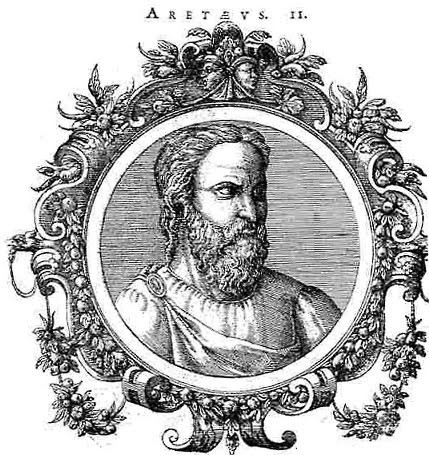Asthma is derived from the Greek verb aazein, meaning shortdrawn breath or panting.
Aretaeus of Cappadocia, a Greek physician, who studied in Alexandria and practiced in Rome probably in the second century CE, is credited with the first accurate description of asthma, as we know it today.

Aretaeus is considered one of the most valuable medical writers of antiquity, an original observer that included in his work his personal experience and also the achievements of anatomy and physiology. His prevailing but incomplete treatises are: De Causis et Signis Morborum Acutorum et Diuturnorum (On the Causes and Symptoms of Acute and Chronic Diseases), in four books, and De Curatione Morborum Acutorum et Diuturnorum (On the Cure of Acute and Chronic Diseases), also in four books.
In Chapter XI of his essay On the Causes and Symptoms, entitled On Asthma, Aretaeus defined the disease, emphasizing the association with exercise: “If from running, gymnastic exercises or from any other work, the breathing becomes difficult, it is called asthma”.
Follower of the Pneumatic school of medicine, he supported that health was preserved by pneuma or “vital air,” and he attributed asthma to a “thick and viscid phlegm caused by coldness and humidity of the pneuma”. Also, he noted that women were more prone to asthma, men were more likely to die of it, and children had a better outlook for recovery.
In his writings, the heart is the source of life and strength that attracts the pneuma into the lungs for subsequent dispersion through the body. Any imbalance in this condition could be fatal. He located asthma in the lungs, supporting the idea that if the patient has simultaneous heart disease, he or she will not survive very long.
Aretaeus, in an excellent clinical sense, described the paroxysm of the disease. The symptoms include chest heaviness, tiredness, and difficulty of breathing. If the patient’s condition gets worse, the symptoms will become more prominent, the cough is frequent and laborious, the expectoration small and thin, the cheeks intensely red, the eyes protuberant, and the voice liquid without resonance. The patient also has a desire to get into open air: “They open the mouth since no house is sufficient for their respiration, they breathily standing, as if desiring to draw in all the air which they possibly can inhale. the neck swells with the inflation of the breath, the precordia retracted, the pulse becomes small and dense,” and if the symptoms persist the patient “may produce suffocation after the form of epilepsy”.
However, as the paroxysm ceases, he states, the cough becomes less urgent and less frequent, the voice sonorous, and the body relaxes. “Thus,” he concludes, “asthmatics escape death, but in the intervals between severe attacks or even when they are walking on ground level, they bear in mind the symptoms of the disease”.
Reading that description, we should realize the value of Aretaeus’s vivid and clear portrayal of asthma over 1,800 years ago, as it remains a landmark in medical history.
(Source: “Aretaeus of Cappadocia and the First Clinical Description of Asthma”, by Marianna Karamanou)

Research-Selection for NovoScriptorium: Maximus E. Niles

Leave a comment